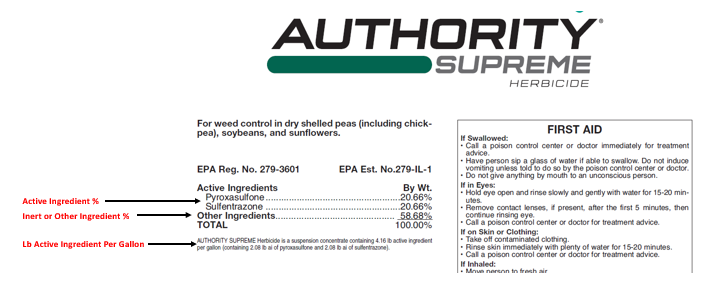ILSOYADVISOR POST
Herbicide Active Ingredients – A Deeper Dive
July 20, 2020
Herbicide active ingredients are the components of a formulation employing phytotoxicity on targeted weed species. Most herbicide labels list active ingredient and inert elements as a percentage by weight as well as pound of active ingredient per gallon or per pound for liquid and dry formulations, respectively.

Referencing herbicide active ingredients for each product is a critical step for any weed management practitioner. This is important to assess and understand for several reasons such as:
- Validating the active ingredient is toxic to the desired weed species
- Reducing the overreliance on specific active ingredients (many of the same active ingredients are utilized in different premixes)
- Verifying that the maximum application limit is not exceeded
- Reviewing potential interactions with other tank-mix partners or sequential applications
- Plant back or crop rotation limitations
In terms of managing resistance, simply selecting a different active ingredient is not always effective. For example, if chlorimuron was employed and the target weed species is ALS-resistant, simply switching to cloransulam would not result in sufficient control as both are ALS-inhibiting herbicides. Multiple-resistant weed biotypes further complicate this process as there are fewer effective options to choose from.
In soybean production, we primarily rely on herbicide active ingredients with 10 unique sites of action. Active ingredients for each site of action encompass utility in controlling specific weed species. When administered in a program, they offer burndown and pre- and postemergence activity providing management of multiple weed species throughout the season.

Herbicide strategies should always begin by facilitating a clean seed bed. Often, marestail and giant ragweed challenge burndown herbicide applications. However, there are several options that when selected and employed in a program will provide adequate activity on these species (e.g., paraquat, 2,4-d, dicamba, saflufenacil, metribuzin). Effective tactics targeting weeds with extended emergence intervals such as amaranthus spp. must include active ingredients conferring residual activity preemergence (e.g., sulfentrazone, flumioxazin, pyroxasulfone, metribuzin, etc.) which may be augmented with materials encompassing activity on large seeded broadleaves (e.g., chlorimuron, cloransulam, etc.) to improve weed spectrum. This, coupled with active ingredients implementing broad spectrum postemergence control within the selected trait system and layered residual (e.g., pyroxasulfone, acetochlor, S-metolachlor, dimethenamid), will assist in controlling emerged vegetation at application as well as preventing weed emergence prior to canopy.
Additionally, weed size at the time of application may influence herbicide efficacy. Targeting bare soil with a layered residual approach or small weeds (<4’’) with post applications is imperative. Furthermore, when utilizing active ingredients with contact activity (e.g., MOA - nitrogen metabolism, cell membrane disruptors) employing higher carrier volume will assist in covering the growing points of targeted weed species.
Research has demonstrated that diverse weed management programs incorporating multiple active ingredients from different sites of action are most effective in controlling problematic weed species. Research conducted by FMC and Purdue University illustrates utilizing different active ingredients in a layered residual program reduces the soil seed bank after being implemented for just one year.

Herbicide tactics should also be enhanced with cultural and mechanical practices to preserve their effectiveness. The main objective of any weed management program should include a zero-tolerance policy for weed escapes with a focus on reducing the soil seedbank. Minimizing the soil seedbank over time represents a sustainable strategy to control weeds. Let’s do our part to understand active ingredient selection to manage weeds throughout the season and preserve vital resources for the crop





Comments
Add new comment